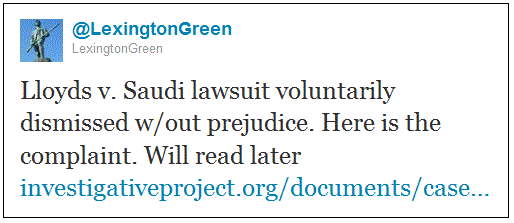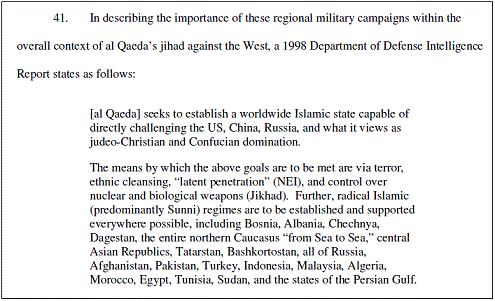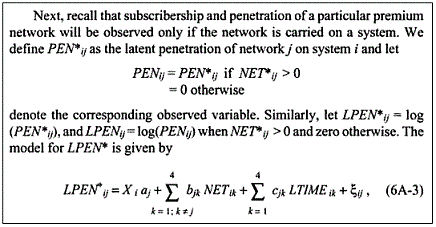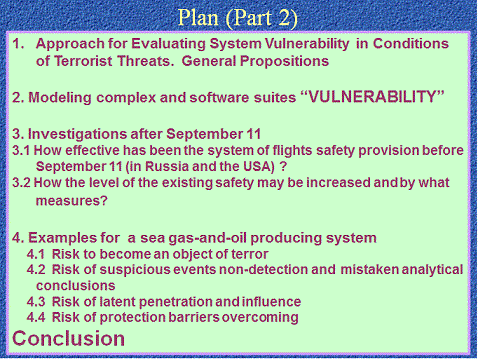Down the rabbit hole: researching the “jikhad”
[ by Charles Cameron — cross-posted from Chicago Boyz – a meander on the perils and promise of research, jihad, typos, books and more ]
.
It begins with an email from Lexington Green saying I might be interested in a tweet he had posted earlier this morning:
The Insurance Journal tells us:
Defendants named in the complaint were Kingdom of Saudi Arabia, The Saudi High Commission for Relief of Bosnia & Herzegovina, Saudi Joint Relief Committee for Kosovo and Chechnya, Saudi Red Crescent Society, National Commercial Bank, Al Rajhi Banking and Investment Company. Also included as defendants are three Saudi citizens connected to these organizations, Prince Salman Bin Abdul Aziz Al Saud, Suleiman Abdel Aziz Al Saud and Yassin Al Qadi.
The case is Underwriting Members of Lloyd’s Syndicate 3500 v. Kingdom of Saudi Arabia, 11-00202, U.S. District Court, Western District of Pennsylvania.
Okay, I’m curious. I go to the complaint [.pdf] and start reading… and on page 9, I find:
That’s interesting. A DIA report, better look that up. But there’s no reference provided…
So I googled for “latent penetration” NEI which sent me back to versions of the court filing, and then for “latent penetration” and found that Robert W. Schaefer on p. 166 of his book, The Insurgency in Chechnya and the North Caucasus: From Gazavat to Jihad, quotes [with minor variations] from what is obviously the same DIA document and in footnote 29, p 165 identifies it as “Declassified DIA intelligence report NC 3095345, October 16, 1998, 3 (obtained through the Freedom of Information Act).”
Onwards to locate NC 3095345, which can be found here [.pdf] and contains the following relevant text on p. 3:
So that’s the source of the description of AQ’s overall plan in the Lloyds complaint.
But what’s “latent penetration”? The DIA document even has it in quote marks – does that make it a technical term?
Back to Google.
The FBI uses the term “latent penetration” – maybe I’m onto something! In their Electronic Biometric Transmission Specification (EBTS) [.pdf] on p. 58 they offer the “following list of TOTs is applicable to latent friction ridge searches transmitted to the FBI”:
I have to admit – a Latent Penetration Query sounds like just the thing I’m after – but the FBI appears to think of “latent penetration” in terms of fingerprints…
Okay, next up. A quick look at David Waterman and Andrew A. Weiss‘ book, Vertical Integration in Cable Television, (AEI, 1997) tells us:
That’s all a bit above my head, and in any case I don’t watch cable TV… and the networks in question aren’t terrorist networks, they’re cable networks…
When I add the word “terror” into my search, however, I get directed to Prof. Kostogryzov Andrey‘s paper [.ppt] addressing the question of a “methodical approach for the evaluation of systems vulnerability in conditions of terrorist threats” for a symposium at the University of Texas, Arlington – which sounds promising.
Searching the good professor’s powerpoint for “latent penetration” takes me to slide 36, however, where I read:
To be honest with you, I don’t feel any closer to understanding “latent penetration” beyond a sort of general “potentially getting inside the opposition” kind of sense.
So let’s get back to NEI – which is what the Lloyds transcription has in parens immediately after the quote-marked phrase “latent penetration” – what’s that about?
Well, on closer examination, it looks as though Lloyds got that wrong, and the DIA document — compare their E’s and F’s in the typed excerpt above and I think you’ll agree — actually says NFI…
Phew! NFI.
What’s that?
The DIA probably classifies its acronyms, but this particular document has been declassified and NFI hasn’t been redacted, so perhaps the Free Dictionary acronym finder will be able to help…
I quickly dismiss such possibilities as National Fatherhood Initiative and get down to my three basic possibilities:
NFI … No Further Information (available)
NFI … National Foreign Intelligence
NFI … No Freaking Idea
The last of these describes my own feelings at this point, although “freaking” would be the milder way to put it. So it’s down to guesswork: I’ll go with #2.
Okay: according to this particular DIA report, AQ “seeks to establish a worldwide Islamic state” by means that include “latent penetration” — I still have only the vaguest idea [OTVI] what that means — and “control over nuclear and biological weapons (Jikhad)”.
Jikhad?
The DIA docu self-describes thus:
Variant spellings, okay…
But I’m wondering if “Jikhad” is one of them…
Back to the search engines, where I discover the word does have prior art in a terrorist – indeed, a specifically AQ — context, to wit:
$149.95, call it $150 on Amazon, and available for free shipping…
Well, you can’t judge a book title by its cover, so I have an inquiry in to the good folks at the University of Calgary library, which has a copy – but I’m guessing “Jikhad” is a typo in both cases, aren’t you?
*
And what grand purpose does all this serve?
None, you may think – the complaint has been withdrawn, as Lex tells us, “without prejudice” – so the issue is, if I may use a legal term despite the fact that IANAL, “moot”.
Unless one is interested in the prices of books these days, or the frequency of spelling vagaries on their printed covers, or possible Arabic words bearing on terrorism that one hasn’t run across previously, or fingerprints, or the reliability of a document of which LTC Schaefer notes (p. 165, n 29):
It is important to note that no evaluation of the information detailed in the report is included in the declassified version; and anyone who deals with intelligence will tell you that text without context is pretext. It is entirely possible that this document was passed to U.S. Intelligence by the Russians in order to bolster the evidence linking the Chechens with Al Qaeda.
On second thoughts, we can learn something here about care in reading sources – about the transmission errors that commonly crop up when texts are translated or transmitted – and about the importance of context.
Text without context is pretext.
That whole paragraph of LTC Schaefer’s is worth the price of admission.











September 22nd, 2011 at 10:33 pm
Here’s an alternative explanation for that spelling (jikhad), Charles.
.
There is no commonly-accepted convention for transliterating Arabic into English. I can’t figure out why scholars can’t agree on this, but I think there isn’t one yet for Russian to English either, and that’s much closer.
.
A strongly aspirated h sounds to some people like a k. We don’t aspirate our hs much in English, although we do some consonants like t and p. I said an Estonian word containing an h to a friend the other day, and she thought it was a k sound. I’ve heard other English speakers make that mistake with Estonian words. Estonians aspirate hs, but not ts and ps.
.
I don’t know enough Arabic to know the proper (un-Anglicized) pronounciation of the word we commonly spell jihad. But I have heard some strongly aspirated hs in Arabic. If it’s one of those, some English speakers will insert a k.
September 22nd, 2011 at 11:06 pm
cheryl offers good points.
.
note that jihad is not the only word spelled with a k: as jikhad.
.
in the text you quote, so is fahd’s name: as fakhd.
.
this may provide indication of likely original source abroad: e.g., russia?
September 22nd, 2011 at 11:32 pm
Okay — and just higher in the same text we have "Omar Adal ((Rakhman)), Egypt" which I think clinches your point, Cheryl & David — and the source was indeed Russian.
September 22nd, 2011 at 11:53 pm
Notwithstanding which…
.
I just heard from Joe Rupnarain at the U Calgary library, who tells me "You are correct in thinking it’s a typo on the cover. The front page, TOC and throughout the book uses jihad and not jikhad."
.
But that’s the book, not the DIA document.
.
My appreciative thanks, Joe Rupnarain!
September 23rd, 2011 at 12:31 am
Hi Charles, Good post! Thanks for sharing! I’ve been buried in other stuff, but have in mind a strateegery piece on the Pacific Rim.
September 23rd, 2011 at 4:07 am
Intriguing post. "Latent penetration" sounds to me like cultivation of sympathizers and setting upof sleeper networks. My two cents.
.
I have often seen Soviet/Russian Muslim names transliterated with a kh where an h would work perfectly well. Some Russian words written in English script will appear similarly , for example Narodny Rukh. It is an Eastern Slavic linguistic tendency, I think
September 23rd, 2011 at 11:59 am
Yes! kh is a reasonable way for a Russian to represent this sound.
September 23rd, 2011 at 12:00 pm
After you transliterate the Cyrillic into Roman, that is.
September 25th, 2011 at 5:26 pm
Folks, folks…..
This discussion of Arabic words is getting far off course. There are two/two “h” sounds in the langauge. One [H] is aspirated and the other, [h] is not. There is a separate and third sound/letter that is aspirated and it is usually typed as “KH” in English.
The word “jihad” contains the NON-aspirated or “simple” “h” that is like the the “h” in English. [So, there is no correct explanation for the extra k.]
The other, aspirated “H” is contained in the word “Hommos”.
I note here that Hebrew speakers, when speaking Arabic or pronouncing an Arabic proper name, often mistakenly use a sound closer to “KH” when pronouncing an Arabic word containing the aspirated H. Hence you may hear Israelis say “Khommos” for that delicious dip.
This KH sound can be found in modern Hebrew with a dedicated letter in its alphabet [I can’t comment on biblical Hebrew.] Frequently, words borrowed from Arabic that include the letter corresponding to H get written in Hebrew with the letter corresponding to the sound KH, not H as in the original Arabic. So….the Hebrew word for Hommos is written in Hebrew using the letter that corresponds to the KH sound. Bottom line, if an Israeli is speaking Hebrew, it is indeed Khommos, but not when speaking Arabic.
As words or proper names traveled across languages by non-Arab Muslims, they had to be accommodated to the sound system and writing system of each language. Hence, the KH spelling in the name Rakhman in Russian and some other languages.
Turkish, which has no “KH” sound or letter and only one, unaspirated, “h”, adjusts Arabic words accordingly: KHaalid=Halit [note the d=t change as well.]
I have used arbitrary English-language Latin letters in this note. However, within the world of scholarship, there are serious standardized equivalents for each Arabic letter that use Latin letters with either extra diacritical marks or new letters, each with a corressponding sound value. In the field of linguistics within the English-sspeaking world, this is true of all languages not originally written in Latin script or any script for non-written langauges.
September 25th, 2011 at 6:20 pm
Hi, 34plt34 — and many thanks.
.
I don’t know about Biblical Hebrew either (I have little Latin and less Greek) – but there’s a table of Biblical Aramaic writing with pronunciation guide in Franz Rosenthal‘s A Grammar of Biblical Aramaic, and by searching via Google for the phrase “sound of incipient vomiting” I was able to locate it:
.
http://books.google.com/books?id=YI5QiMWNougC&pg=PA11
.
I bought the book while up at Oxford about fifty years ago and never got much farther than that phrase, which has been stuck in one of the crevices of my brain ever since — I had no idea at the time that learning could be so much fun.
.
I guess the relevant letters here would be he, het, and kap.
.
And the real point I’m making with this post, strongly reinforced by the comments here, is how wide and varied a knowledge base we may need access to, if we are to fully understand even one single sentence in a DOD file containing notes on AQ’s approach to jihad…
September 26th, 2011 at 2:32 am
Thanks, Charles Cameron for that further linguistic info and insights!
On your central point, yes, a whole lot just flies by most of us because we do not know the cultural reference points. For instance, the name of a fairly well-known jihadi product was entitled “The Night of Bush’s Arrest.” I don’t know anyone in our field who realized that this is a play on the name of a well-known Egyptian movie, “The Night of Fatma’s Arrest.” Religous allegories and metaphors are even further out of our scope. For something like that, even being a native speaker is not necessarily enough…you have to know something about pop culture. This is especially important because most of these jihadis are “young guys” who did and probably still do partake in the wider world of entertainment in their cultures.
The good news on this score is that jihad expert Tom Hegghammer is now focusing on cultural aspects of their texts and web productions, especially the poetry but also the music, art work, etc. he is hoping to get out an edited work for starters. Contributors will be specialists in musicology and anthropology, etc, but with the knowledge of the cultures under study.
Re Aramaic, I do not know the language, but at least in its Eastern Christian religious and contemporary native language forms, the sound system and alphabet seem closer to Hebrew than Arabic. For instance, Arabic words that use the “s” are similar in Aramaic, but with the “sha” substituted for the “s.”